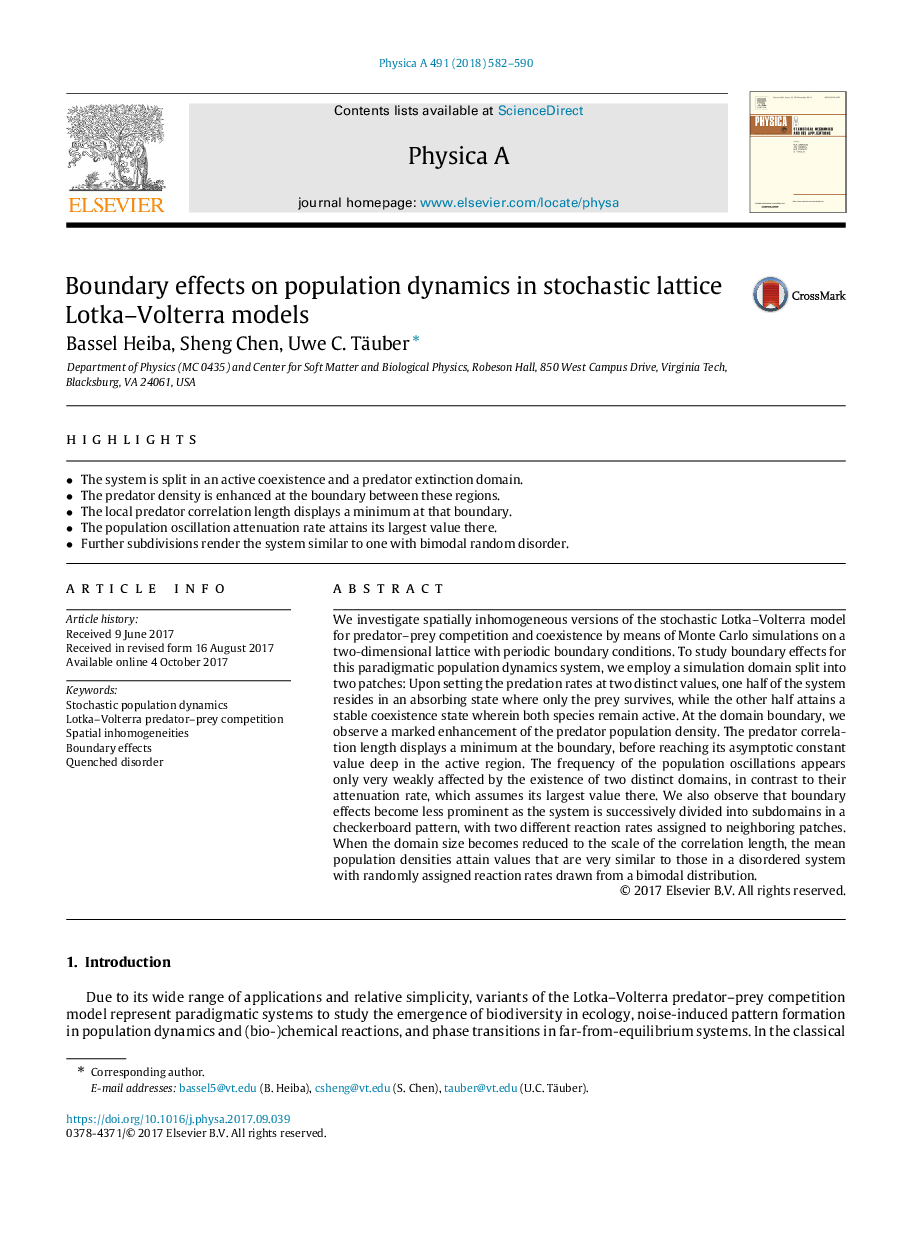| کد مقاله | کد نشریه | سال انتشار | مقاله انگلیسی | نسخه تمام متن |
|---|---|---|---|---|
| 5102388 | 1480082 | 2018 | 9 صفحه PDF | دانلود رایگان |
عنوان انگلیسی مقاله ISI
Boundary effects on population dynamics in stochastic lattice Lotka-Volterra models
ترجمه فارسی عنوان
اثرات مرزی بر پویایی جمعیت در مدل های لاکه-ولتررا شبکه تصادفی
دانلود مقاله + سفارش ترجمه
دانلود مقاله ISI انگلیسی
رایگان برای ایرانیان
کلمات کلیدی
دینامیک جمعیت تصادفی، رقابت شکارچی لوتاکا-ولتررا، عدم انحراف فضایی، اثرات مرزی، اختلال خاموش
ترجمه چکیده
ما به بررسی نسخه های غیرموجبانه مدل لخت-ولتررا تصادفی برای رقابت شکارچی و همزیستی با استفاده از شبیه سازی های مونت کارلو در شبکه ی دو بعدی با شرایط مرزی دوره ای پرداخته ایم. برای مطالعه اثرات مرزی برای این سیستم دینامیکی جمعیت پارادایمی، ما یک دامنه شبیه سازی را به دو تکه تقسیم می کنیم: پس از تنظیم میزان شکار در دو مقطع مجزا، یک نیمی از سیستم در یک کشور جذب می شود، در حالی که تنها شکار زنده می ماند، در حالی که دیگر نیمی از حالت همزیستی پایدار را به دست می آورد که در آن هر دو گونه فعال می شوند. در مرز دامنه، افزایش قابل توجهی از تراکم جمعیت شکارچی مشاهده می شود. طول همبستگی شکارچی حداقل در مرز نمایش داده می شود، قبل از رسیدن به مقدار پایدار آستانه آن در عمق منطقه فعال. فرکانس نوسانات جمعیت به نظر می رسد تنها با ضعف ناشی از وجود دو حوزه متمایز، بر خلاف میزان انقباض آن، که بیشترین مقدار آن را در بر می گیرد، تحت تأثیر قرار می گیرد. ما همچنین مشاهده می کنیم که اثرات مرزی کمتر قابل توجه است زیرا سیستم به طور متوالی به زیر دامنه ها در الگوی شطرنجی تقسیم می شود، با دو میزان واکنش مختلف واکنش نسبت به تکه های همسایه. هنگامی که اندازه دامنه به مقیاس طول همبستگی کاهش می یابد، میانگین تراکم جمعیت به مقادیری می رسد که بسیار شبیه به آن ها در یک سیستم اختلال است و نرخ های واکنش تصادفی تعیین شده از توزیع دوطرفه.
موضوعات مرتبط
مهندسی و علوم پایه
ریاضیات
فیزیک ریاضی
چکیده انگلیسی
We investigate spatially inhomogeneous versions of the stochastic Lotka-Volterra model for predator-prey competition and coexistence by means of Monte Carlo simulations on a two-dimensional lattice with periodic boundary conditions. To study boundary effects for this paradigmatic population dynamics system, we employ a simulation domain split into two patches: Upon setting the predation rates at two distinct values, one half of the system resides in an absorbing state where only the prey survives, while the other half attains a stable coexistence state wherein both species remain active. At the domain boundary, we observe a marked enhancement of the predator population density. The predator correlation length displays a minimum at the boundary, before reaching its asymptotic constant value deep in the active region. The frequency of the population oscillations appears only very weakly affected by the existence of two distinct domains, in contrast to their attenuation rate, which assumes its largest value there. We also observe that boundary effects become less prominent as the system is successively divided into subdomains in a checkerboard pattern, with two different reaction rates assigned to neighboring patches. When the domain size becomes reduced to the scale of the correlation length, the mean population densities attain values that are very similar to those in a disordered system with randomly assigned reaction rates drawn from a bimodal distribution.
ناشر
Database: Elsevier - ScienceDirect (ساینس دایرکت)
Journal: Physica A: Statistical Mechanics and its Applications - Volume 491, 1 February 2018, Pages 582-590
Journal: Physica A: Statistical Mechanics and its Applications - Volume 491, 1 February 2018, Pages 582-590
نویسندگان
Bassel Heiba, Sheng Chen, Uwe C. Täuber,
